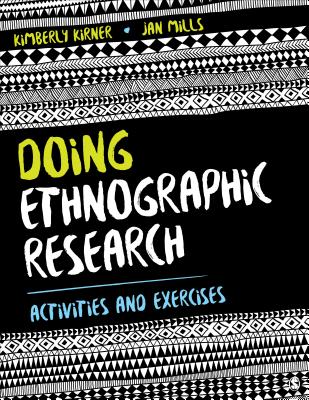图书简介
A workbook built for application, Doing Ethnographic Research prepares your students to become effective ethnographic researchers. With activities to practice and reinforce each step of the research process, this book serves as the perfect compliment to the text, Introduction to Ethnographic Research, also written by the same authors.
1. The Basics of Research Design \\ Activity 1.1: Ways of Knowing (Personal Reflection) \\ Activity 1.2: Identifying Researchers’ Approach \\ Activity 1.3: Dependent and Independent Variables \\ Activity 1.4: Variables, Indicators, and Values \\ Activity 1.5: Operationalizing Definitions \\ Activity 1.6: Research Interest Reflection \\ Activity 1.7: Finding a Topic: Your Research Project \\ Chapter 1 Reflection \\ Self- or Peer-Assessment for Chapter 1 \\ 2. Ethics \\ Activity 2.1: Personal Ethics Self-Evaluation (Personal Reflection) \\ Activity 2.2: Operationalizing the AAA Code of Ethics \\ Activity 2.3: Exploring Relationships of Responsibility \\ Activity 2.4: Ethical Dilemmas \\ Activity 2.5: Research Design Decisions: Recruitment \\ Activity 2.6: Research Design Decisions: Positionality \\ Activity 2.7: Research Design Decisions: Risk Assessment and Management \\ Chapter 2 Reflection \\ Self- or Peer-Assessment for Chapter 2 \\ 3. Sampling \\ Activity 3.1: Personal Sampling Self-Evaluation (Personal Reflection) \\ Activity 3.2: Cultural Data versus Individual Attribute Data \\ Activity 3.3: NonProbability Sampling Plans \\ Activity 3.4: Critiquing the Choice of Informants \\ Activity 3.5: Probability Sampling Plans \\ Activity 3.6: Sampling Frames \\ Activity 3.7: Research Design Decisions: Sampling Plan \\ Chapter 3 Reflection \\ Self- or Peer-Assessment for Chapter 3 \\ 4. Participant Observation \\ Activity 4.1: Participant Observation Self-Evaluation (Personal Reflection) \\ Activity 4.2: Showing, Not Telling \\ Activity 4.3: Reflexivity \\ Activity 4.4: Introductory Participant Observation \\ Activity 4.5: Research Design Decisions: Anticipating Field Challenges and Planning for Where/When/How/What \\ Activity 4.6: Research Project: Participant Observation—Jottings \\ Chapter 4 Reflection \\ Self- or Peer-Assessment for Chapter 4 \\ 5. Writing Field Notes \\ Activity 5.1: Writing Field Notes Self-Evaluation (Personal Reflection) \\ Activity 5.2: Correcting Pitfalls \\ Activity 5.3: Selection: Inscribing Reality \\ Activity 5.4: Presentation: Inscribing Reality \\ Activity 5.5: Analytical Commentaries \\ Activity 5.6: Research Project: Writing Field Notes \\ Activity 5.7: Autoethnography \\ Chapter 5 Reflection \\ Self- or Peer-Assessment for Chapter 5: Activity 5.6 \\ Self- or Peer-Assessment for Chapter 5: Activity 5.7 \\ 6. Interviewing \\ Activity 6.1: Interviewing Self-Evaluation (Personal Reflection) \\ Activity 6.2: Correcting Interview Questions \\ Activity 6.3: Constructing an Interview Guide for Peer Interviews \\ Activity 6.4: Constructing an Informed Consent Form for Peer Interviews \\ Activity 6.5: Peer Interviews \\ Activity 6.6: Research Design Decisions: Preparing an Interview Guide and a Consent Form \\ Activity 6.7: Research Project: Interviews \\ Chapter 6 Reflection \\ Self- or Peer-Assessment for Chapter 6 \\ 7. Coding and Analysis \\ Activity 7.1: Coding and Analysis Self-Evaluation (Personal Reflection) \\ Activity 7.2: Abbreviating, Coding, and Analysis \\ Activity 7.3: Inductive versus Deductive Coding \\ Activity 7.4: Manifest versus Latent Content \\ Activity 7.5: Content Analysis of TV Shows \\ Activity 7.6: Practicing Grounded Theory \\ Activity 7.7: Research Project: Coding and Analysis Using Grounded Theory \\ Activity 7.8: Writing Ethnographic Narrative \\ Chapter 7 Reflection \\ Self- or Peer-Assessment for Chapter 7: Activity 7.7 \\ Self- or Peer-Assessment for Chapter 7: Activity 7.8 \\ 8. Surveys and Mixed Methods Design \\ Activity 8.1: Reflections on User Experience Self-Evaluation (Personal Reflection) \\ Activity 8.2: Mixed Methods Design \\ Activity 8.3: Triangulation \\ Activity 8.4: Practicing Constructing Survey Questions \\ Activity 8.5: Practicing Survey Distribution Decisions \\ Activity 8.6: Practicing Survey Data Analysis \\ Activity 8.7: Research Design Decisions: Constructing Survey Questions \\ Activity 8.8: Research Design Decisions: Preparing a Survey and Consent Page \\ Activity 8.9: Research Project: Survey Data Collection, Analysis, and Write-Up \\ Chapter 8 Reflection \\ Self- or Peer-Assessment for Chapter 8 \\ 9. Cultural Domains: Modeling Cognition and Knowledge \\ Activity 9.1: My Taxonomies and Cultural Models Self-Evaluation (Personal Reflection) \\ Activity 9.2: Practicing Folk Taxonomy Study Design \\ Activity 9.3: Practicing Folk Taxonomy Data Collection and Analysis \\ Activity 9.4: Practicing Cultural Models Study Design \\ Activity 9.5: Practicing Cultural Model Data Collection and Analysis \\ Activity 9.6: Practicing Decision-Tree Model Study Design \\ Activity 9.7: Practicing Decision-Tree Model Data Collection and Analysis \\ Activity 9.8: Research Design Decisions: Cultural Domains Study \\ Activity 9.9: Research Project: Cultural Domain Study \\ Chapter 9 Reflection \\ Self- or Peer-Assessment for Chapter 9 \\ 10. Indirect Observation: Material Culture and Using Archives or Media \\ Activity 10.1: My Indirect Observation Self-Evaluation (Personal Reflection) \\ Activity 10.2: Practicing Visual and Material Culture Study Design \\ Activity 10.3: Practicing Visual and Material Culture Collection and Analysis \\ Activity 10.4: Practicing Diary Study Design \\ Activity 10.5: Practicing Diary Study Collection and Analysis \\ Activity 10.6: Practicing Archival Study Design \\ Activity 10.7: Practicing Archival Study Collection and Analysis \\ Activity 10.8: Research Design Decisions: Selecting an Indirect Observation Study \\ Activity 10.9: Research Project: Indirect Observation Study \\ Chapter 10 Reflection \\ Self- or Peer-Assessment for Chapter 10 \\ 11. Behavior and Context: Mapping and Passive Direct Observation \\ Activity 11.1: Behavior and Context Self-Evaluation (Personal Reflection) \\ Activity 11.2: Practicing Participatory Mapping Study Design \\ Activity 11.3: Practicing Participatory Mapping \\ Activity 11.4: Practicing Mobility Mapping \\ Activity 11.5: Continuous Monitoring: Creating an Ethogram \\ Activity 11.6: Continuous Monitoring: Using an Ethogram and Writing \\ Activity 11.7: Research Design Decisions: Selecting a Behavior and Context Study \\ Activity 11.8: Research Project: Behavior and Context Study \\ Chapter 11 Reflection \\ Self- or Peer-Assessment for Chapter 11 \\ 12. Putting It All Together: Culminating Experiences \\ Activity 12.1: Integrating Skills Self-Evaluation (Personal Reflection) \\ Activity 12.2: Human Subjects Protocol for Institutional Review Board (IRB) \\ Activity 12.3: Grant Proposal \\ Activity 12.4: Technical Report \\ Activity 12.5: Paper Presentation \\ Activity 12.6: Poster Presentation \\ Chapter 12 Reflection \\ Self- or Peer-Assessment for Chapter 12: Activity 12.2 \\ Self- or Peer-Assessment for Chapter 12: Activity 12.3 \\ Self- or Peer-Assessment for Chapter 12: Activity 12.4 \\ Self- or Peer-Assessment for Chapter 12: Activity 12.5 \\ Self- or Peer-Assessment for Chapter 12: Activity 12.6
Trade Policy 买家须知
- 关于产品:
- ● 正版保障:本网站隶属于中国国际图书贸易集团公司,确保所有图书都是100%正版。
- ● 环保纸张:进口图书大多使用的都是环保轻型张,颜色偏黄,重量比较轻。
- ● 毛边版:即书翻页的地方,故意做成了参差不齐的样子,一般为精装版,更具收藏价值。
关于退换货:- 由于预订产品的特殊性,采购订单正式发订后,买方不得无故取消全部或部分产品的订购。
- 由于进口图书的特殊性,发生以下情况的,请直接拒收货物,由快递返回:
- ● 外包装破损/发错货/少发货/图书外观破损/图书配件不全(例如:光盘等)
并请在工作日通过电话400-008-1110联系我们。
- 签收后,如发生以下情况,请在签收后的5个工作日内联系客服办理退换货:
- ● 缺页/错页/错印/脱线
关于发货时间:- 一般情况下:
- ●【现货】 下单后48小时内由北京(库房)发出快递。
- ●【预订】【预售】下单后国外发货,到货时间预计5-8周左右,店铺默认中通快递,如需顺丰快递邮费到付。
- ● 需要开具发票的客户,发货时间可能在上述基础上再延后1-2个工作日(紧急发票需求,请联系010-68433105/3213);
- ● 如遇其他特殊原因,对发货时间有影响的,我们会第一时间在网站公告,敬请留意。
关于到货时间:- 由于进口图书入境入库后,都是委托第三方快递发货,所以我们只能保证在规定时间内发出,但无法为您保证确切的到货时间。
- ● 主要城市一般2-4天
- ● 偏远地区一般4-7天
关于接听咨询电话的时间:- 010-68433105/3213正常接听咨询电话的时间为:周一至周五上午8:30~下午5:00,周六、日及法定节假日休息,将无法接听来电,敬请谅解。
- 其它时间您也可以通过邮件联系我们:customer@readgo.cn,工作日会优先处理。
关于快递:- ● 已付款订单:主要由中通、宅急送负责派送,订单进度查询请拨打010-68433105/3213。
本书暂无推荐
本书暂无推荐















